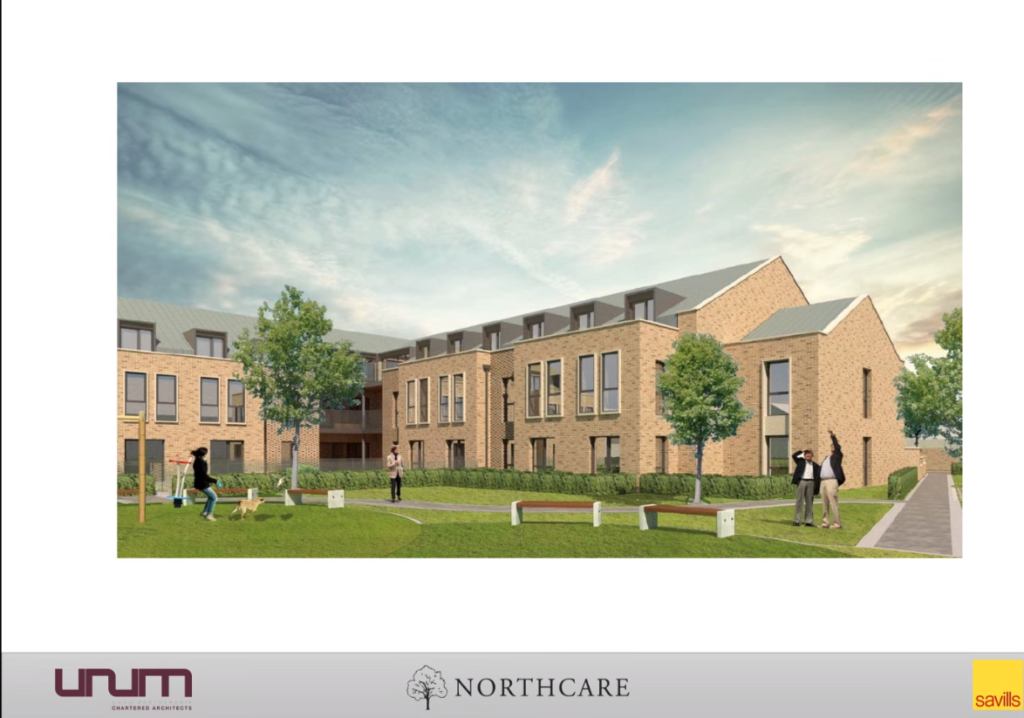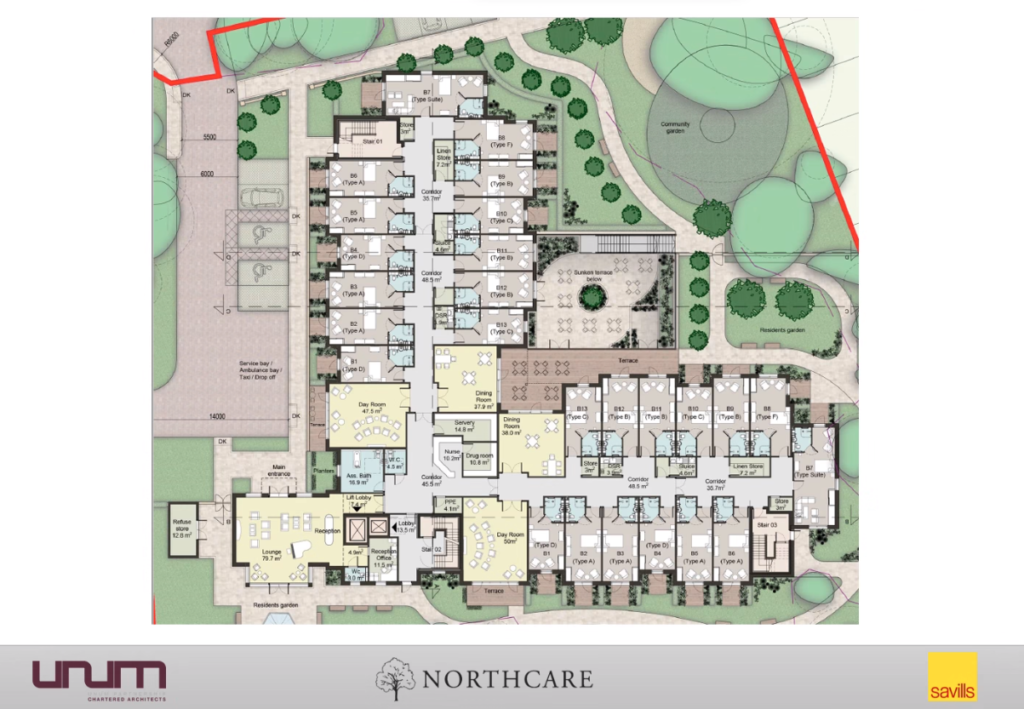The previous attempt at development
From the 1940s onward the undeveloped ‘backland’ (lying behind the terraces of Brewster Gardens, Dalgarno Gardens, and the northern section of Highlever Road) was used by Clifton Nurseries. In 2014 this company left the site and the land was marketed as a ‘residential development opportunity’.
A four year saga followed with the owners of the land (the Legard family, in Yorkshire) working with developers Metropolis Property Ltd on proposals for 20 ‘townhouses’ on the site (see below).

A similar effort is now being mounted by care home company Northcare (Scotland) Ltd to develop a 72 bed care home on this land. A pre-application consultation was launched by the ‘community engagement’ consultancy Concilio on February 29th 2023
Back in 2014/5, the StQW Neighbourhood Plan was at an advanced stage of preparation, after much hard work by local residents. The Draft Plan proposed designation of the remaining three ‘backlands’ in the neighbourhood as ‘Local Green Space’. This was a new planning designation at that time, intended by Government to protect smallish areas of open space valued by local people.
Neighbourhood plans (introduced via the 2011 Localism Act) have always been the primary means of designating Local Green Spaces. There are now over 600 such open spaces protected across England (although not many in London).
The three Local Green Spaces in our neighbourhood are the West London Bowling Club, the Kelfield Gardens backland (owned by the Methodist Church, and Nursery Lane (inherited by the Legard family in the 1950s through marriage into the St Quintin family). W H St Quintin laid out the streets of this corner of North Kensington with the intention that these ‘backland’ spaces be used for sports and recreation. The Bowling Club dates from this time. Nursery Lane was the Ashfield Tennis Club until the 1940s.
This history and the justification for these LGS designations is set out in the StQW Neighbourhood Plan. When the Draft Plan was examined by an ‘independent examiner’ he held a public hearing, listened to evidence from consultants acting for Metropolis Property and from local residents and StQW, and inspected the site (by then not looking at its best after lying unused for 2 years).
The independent examiner’s report recommended to RBKC that all three backlands should be designated as Local Green Space. This is a strong protection against any form of ‘development’ (as defined in the 1990 Town and Country Planning Act). The examiner said in his report I do not regard the site as previously developed land. This was despite the efforts of the Metropolis to argue to the contrary (‘previously developed land’ is a term from the National Planning Policy Framework applied to ‘brownfield land’).
Following this independent examination in 2016 the Legard family and Metropolis applied for judicial review of the Council’s decision to progress the neighbourhood plan to a local referendum.
This JR application was defended by the Council, with the StQW Forum as an ‘interested party’. The High Court case was not heard until late 2017. Meanwhile the Draft Neighbourhood Plan was voted on at a local referendum in February 2016, with 91% support on a 23% turnout of registered electors in the area. In 2018 the JR application was dismissed.
The Council adopted the StQW Neighbourhood Plan in July 2018, as part of the statutory development plan for the Borough. This remains the position in the new Draft RBKC Local Plan, as submitted in January 2023 for ‘examination’ by a Planning Inspector.
These decisions of the Council and the High Court have left the site with only a very limited range of permissible uses that are compatible with a Local Green Space designation. A Certificate of Lawful Development for (non-retail) nursery garden use was granted by RBKC and Mark Enright’s business took up a tenancy from the Legards. As a result of rent increases, Mark is relocating this part of his business in September 2023.
Previous posts on this site give more detail of the 2014-2018 episode. This part of a long saga remains relevant to what happens next on this piece of land.
The latest proposals
Having heard from neighbours overlooking the site that visits were taking place from what looked like various surveyors and consultants, StQW wrote to the Legards asking if they had future plans for the site. The brief response on 15th November 2022 was ‘The family have no future plans for the Nursery Lane site at this moment in time’.
Since then, events have moved fast. With no attempt to consult the neighbourhood forum or residents in the immediate area, a pre-application consultation was started on 20th February by ‘community engagement’ consultants Concilio. We had picked up at the end of January that Savills had made representations to RBKC on behalf of Northcare, as part of the consultation on the Council’s new Draft Local Plan.

From Savills presentation 9th February
As yet, we do not know when and why any contact was established between Northcare (Scotland) Ltd and the Legard family. In response to our queries on the present ownership of the site, Concilio told us on 8th February With regards to ownership of the site I can confirm ‘The Leggard family own the site although Northcare control it as we have a missive in place with an option to purchase subject to planning permission.’
This arrangement is similar to that established between the Legards and Metropolis Property Ltd. As yet there is no entry on the Land Registry title referring to an interest in the landholding by Northcare.

Our letter to Savills of 14th February, following our online meeting with them and Concilio on the 9th February, can be read and downloaded below. This letter set out our understanding of the specific planning context of the site. An annex to the letter gives the conclusions of Mr Justice Dove in his 2018 judgment on the High Court case.
We want to be sure that Northcare have the full factual background to the 2014-18 period. We cannot tell what they have been told by the Legards. This company should not remain under any illusions as to the planning status and history of a 50 year period of attempts to develop this site. These include earlier applications (by RBKC in 1970) and by the Legards in 1981. Planning inquiries were involved in both cases, with the Inspectors deciding against the proposed developments, in the interests of retaining open space as designed into the street layout 120 years ago.
As an outcome of the 1970 RBKC application, the Inspector conceded that the southern part of the original backland could be a suitable location for sheltered housing. The present building a 1 Nursery Lane was built in 1979 as a result. The 38 flats in this sheltered housing continue to be managed by the Council. The flats are being upgraded with the installation of wetrooms as and when residents change over, and the interior of the building has been refurbished.
The Nursery Lane sheltered housing does not provide for clients with dementia or high dependency needs. Neighbouring care homes do so (at Princess Louise in Pangbourne Avenue and at Alan Morkhill House in St Marks Road).
The Council’s initial response to the proposals from Northcare
It is not unusual for companies involved in property development to seek out possible suitable sites to add to their portfolio. Savills act for many such clients. Savills on behalf of Northcare submitted a representation to RBKC as part of the autumn 2022 consultation on the Regulation 19 version of the new Draft Local Plan.
This representation can be read/downloaded below. It argues that the Draft Local Plan is ‘unsound’ in failing to provide for sufficient numbers of additional care home places during the ‘plan period’ of 2021 -2041. It continues by making a case for the suitability of the Nursery Lane site and proposes that the Local Green Space designation is unwarranted and should be ‘removed’ from the new Local Plan, as part of the Examination yet to be held.
The Council’s view on this representation is set out in the schedule of responses approved by full Council on 1st February 2023 and since submitted to the Secretary of State for Examination. This response reads as below:
RBKC response to Savills representation on behalf of Northcare (Scotland) Ltd (page 196 of RBKC Consultation Schedule – Publication Policies (Regulation 19) January 2023)
The St Quintin and Woodlands Neighbourhood Plan (July 2018) Local Green space designation for the Nursery Lane site went through examination and the independent examiner concluded that the site was demonstrably special to the local community and should be designated as Local Greenspace.
In his report dated 26 October 2015 the Inspector found the site to be a tranquil green space where a significant number of households have a view of it. Reference was made to the consultation statement recording the wildlife and birds that had been seen on the site listing the species. It was also concluded by the examiner that it was an historical backspace that had been designed for this purpose.
There is no justification for revisiting the Neighbourhood Plan designation as part of the Local Plan examination process and indeed the Neighbourhood Plan is part of the Development Plan for the borough.
The site designation is not unsound and there is not a critical need for care home accommodation in the borough which dictates that a care home needs to go on this site. Paragraph 103 of the revised NPPF (2021) makes clear that a Local Greenspace designation carries significant weight stating, “Policies for managing development within a Local Greenspace should be consistent with those for Green Belts.”
We are disappointed that the Concilio letter of 20th February, widely distributed locally and launching the pre-application consultation, makes no mention of this response from the local planning authority. Nor does the material on the Concilio consultation website at https://nurserylanecare.co.uk/ A balanced picture of the planning context of the site is not being provided by the consultants acting for Northcare.
We have suggested to Concilio that the claims made on their website, on the need for care home places in the Borough, are misleading without also referring to what the Council has said above in its response to Savills. Yes, there will be demand for more care home places in this and every London Borough. Yes, ‘bed-blocking’ has been a major problem for NHS and social care provision for decades, given the UK’s post-war history of separating these two parts of the public sector.
But to claim that A number of very high-dependency and vulnerable residents would otherwise have to have an enforced hospital stay without access to this new care home is in our view alarmist, unevidenced, and a simplistic attempt to gain public support for a commercially driven planning proposal.
As the Borough with the highest housing values in the country, the Borough already has a range of ‘luxury’ care homes. More will appear in the coming years, in response to market demand. Meanwhile we have sufficient faith in the Council’s planning department to believe that it has prepared a Local Plan that addresses future ‘need’. No other representations were made questioning this aspect of the Local Plan.
StQW/SHRA will be holding one or more open meetings on these proposals from Northcare, before commenting on planning application. Our initial view is that the best time to undertake any form of new care home or housing for the elderly would be when RBKC chooses to rebuild and/or expand the current sheltered housing at Nursery Lane, making full use of the land currently occupied by the roadway and the fact that the southern third of the original backland is already ‘developed land’.

